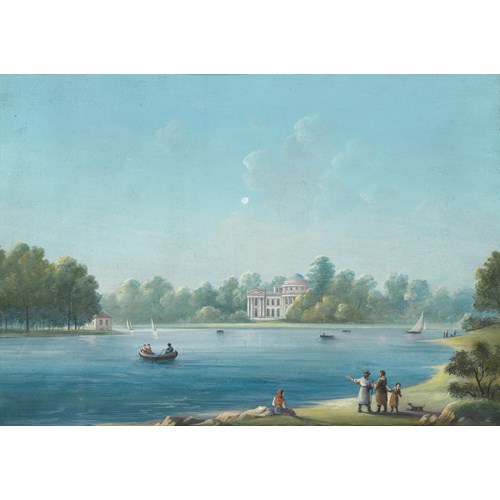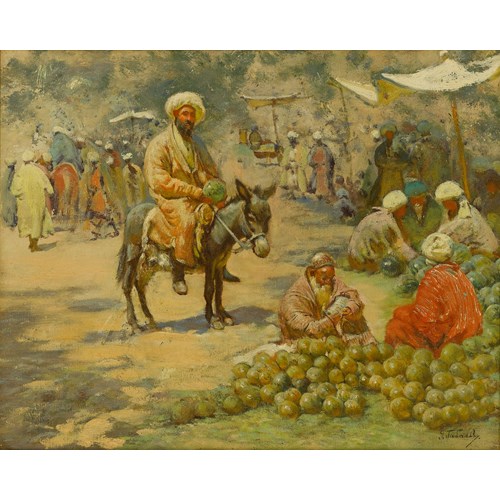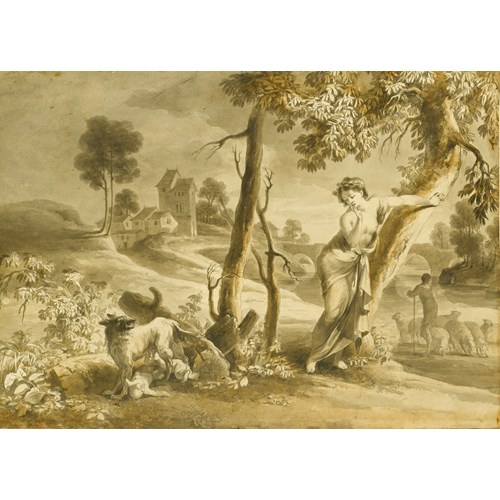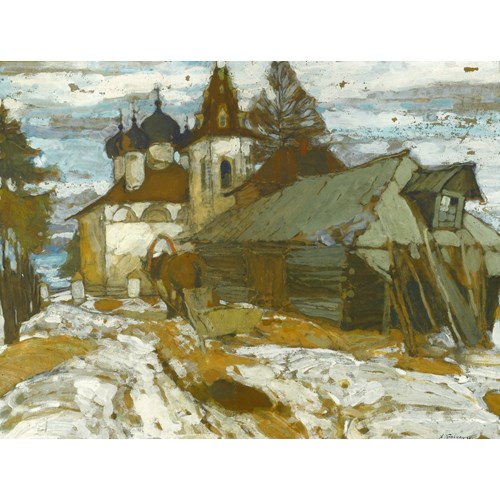Nikita Ivanovich Martos
View of the St. Petersburg Stock Exchange
Epoque 1750-1850, 19th century
Origine Russia, France
Medium Watercolour on paper
Dimension 20.3 x 41.3 cm (8 x 16¹/₄ inches)
The Old Stock Exchange in St. Petersburg, and the Rostral Columns which stand in front of it, were designed by the French architect Jean-François Thomas de Thomon (1754-1813) and completed in 1811. Given that Martos died two years later in France, this watercolour must be a very early view of the building. The Old Stock Exchange is sited on the spit of Vasilievsky Island, so that it looks out over the River Neva to the Winter Palace on the opposite bank. Thomon’s design for the Stock Exchange is a fine example of neo-Classical architecture and is inspired by the Greek Temple of Hera at Paestum. Forty-four Doric columns support a decorative entablature, filled with triglyphs and metopes and crowned by a magnificent sculpture of Neptune. The portico is framed by two rostral columns, decorated with representations of the major rivers of Russia, and the surmounted by braziers, so that the columns acted as beacons, as can be seen in the present work.
The Old Stock Exchange can be considered a key part of the neo-Classical building program that dominated architectural developments in St. Petersburg in the first part of the nineteenth-century. Under Tsars Alexander I (1777-1825) and Nicholas I (1796-1855) ‘Catherine the Great’s dreams of a utopia in Neoclassical garb containing the entire living environment of European Russia became actuality, as a result of strict legislative control of architecture and urban planning’.¹ This building program would obviously have played a key role in Martos’ career as an architect and his interest in the ‘leading architectural example of neo-Classical St. Petersburg’ is clear from this watercolour.² The changing face of St. Petersburg was recorded by a number of artists, including Martos, and so there are a large number of contemporary works comparable to the present watercolour.
Unfortunately very little is known about Martos’ life, as his career ended prematurely and is overshadowed by his famous father, Ivan Petrovich Martos (1754-1835), one of the foremost Russian sculptors of his time, who was one of the leading proponents of neo-Classicism and was patronised by the Tsars.
¹ Shvidkovskiĭ, D. O., Russian Architecture and the West (Yale University Press, 2007) p. 291.
² ibid. pp. 296-297.
Epoque: 1750-1850, 19th century
Origine: Russia, France
Medium: Watercolour on paper
Signature: Bears the inscription ‘Par Martos, Architecte de sa Majesté l’Empereur de toutes les Russiea’ and titled ‘Vue du Pallais de la Bourse de St. Petersburg’ (on the mount).
Dimension: 20.3 x 41.3 cm (8 x 16¹/₄ inches)
Provenance: Sotheby's New York, Property of a Private Collection, 28th October 1988, lot 27, wrongly attributed to Nikita Petrovich Martos.
Plus d'œuvres d'art de la Galerie









